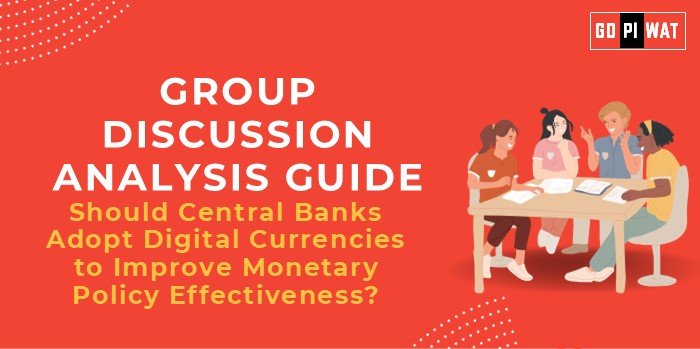📋 Group Discussion Analysis Guide
Should Central Banks Adopt Digital Currencies to Improve Monetary Policy Effectiveness?
🌐 Introduction to the Topic
Central Bank Digital Currencies (CBDCs) are emerging as a transformative financial innovation, reshaping how monetary policy can address contemporary economic challenges. In the wake of declining cash usage and the rise of decentralized cryptocurrencies, CBDCs offer a regulated alternative, promising efficiency, inclusivity, and control.
📊 Quick Facts and Key Statistics
- 📈 Countries Exploring CBDCs: Over 100 central banks globally, including India, are piloting or researching CBDCs.
- 💰 Digital Currency in Circulation: China’s digital yuan has processed over $250 billion in transactions since 2020.
- 💡 Cost Savings: CBDCs could reduce cash management costs by up to 30% for central banks.
- 🌍 Unbanked Population: Globally, 1.4 billion adults lack access to banking, which CBDCs can potentially address.
👥 Stakeholders and Their Roles
- Central Banks: Issuers and regulators ensuring economic stability and policy effectiveness.
- Commercial Banks: Partners or competitors depending on the CBDC model.
- Government Bodies: Facilitators of legal and policy frameworks.
- Citizens and Businesses: Beneficiaries of enhanced efficiency and inclusion.
- Global Institutions (e.g., IMF, BIS): Advocates for international standards and cross-border interoperability.
✅ Achievements and Challenges
🌟 Achievements:
- 🎯 Monetary Policy Control: Enables negative interest rates and direct fiscal transfers.
- 📱 Financial Inclusion: Digital access for unbanked populations.
- 💸 Cost Efficiency: Lower currency management and transaction costs.
- 🔒 Transparency and Security: Reduces tax evasion and illicit activities.
⚠️ Challenges:
- 💵 Implementation Costs: High investment in infrastructure.
- 🔓 Cybersecurity Risks: Increased threat of digital fraud.
- 🏦 Impact on Banks: Potential disintermediation of traditional banking.
- 🕵️ Privacy Concerns: Balancing transparency with individual freedoms.
🌍 Global Comparisons
- 🇨🇳 China: Digital yuan exemplifies state-led innovation but faces privacy concerns.
- 🇸🇪 Sweden: E-krona addresses declining cash usage.
- 🇧🇸 Bahamas: Sand Dollar enhances financial inclusion in remote areas.
Case Study: India’s E-Rupee Pilot successfully demonstrated use cases in wholesale and retail settings, emphasizing interoperability and user adoption.
📚 Structured Arguments for Discussion
- Supporting Stance: “CBDCs empower central banks with direct tools to stimulate economies, particularly in crises.”
- Opposing Stance: “Centralized digital currencies threaten privacy and risk displacing commercial banks.”
- Balanced Perspective: “While CBDCs offer strategic advantages, their success hinges on robust frameworks addressing privacy and cybersecurity.”
🔑 Effective Discussion Approaches
- Opening Approaches:
- 🧮 Reference global pilots, such as China’s digital yuan.
- 📉 Highlight challenges in existing monetary systems.
- Counter-Argument Handling:
- Acknowledge concerns like privacy.
- Emphasize mitigating measures, such as tokenized anonymity.
📋 Strategic Analysis of Strengths and Weaknesses
- Strengths: Policy effectiveness, financial inclusion, cost reduction.
- Weaknesses: Implementation costs, privacy issues.
- Opportunities: Global leadership, innovative monetary tools.
- Threats: Cyber risks, resistance from banking sectors.
🎓 Connecting with B-School Applications
- Real-World Applications: Explore themes like financial inclusion, fintech innovations, and economic policy in projects.
- Sample Interview Questions:
- 💡 “How could CBDCs impact inflation management?”
- 🔎 “What are the risks of displacing commercial banks?”
- Insights for Students:
- Opportunities in fintech and banking.
- Analysis of monetary policy tools.


